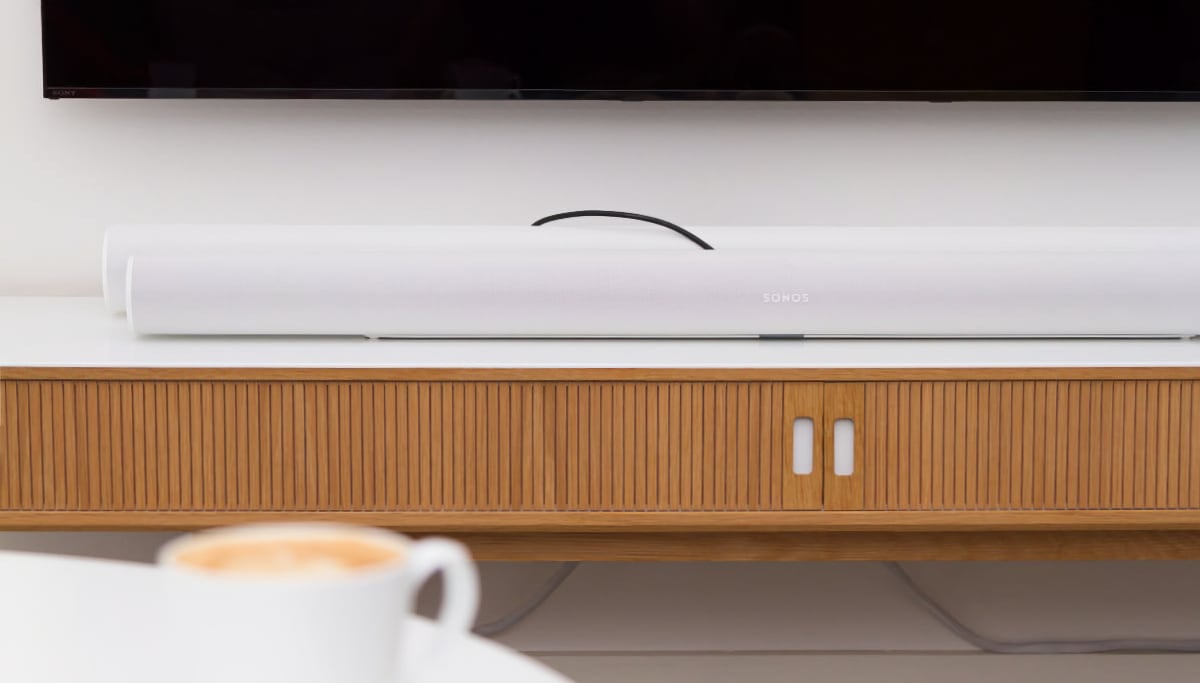Sonos Arc Ultra – Specifications
| |
|---|
| Design | Soundbar |
| - Colors | Black or white | | - Dimensions (HxWxD) | 7.5 x 117.8 x 11.1 cm | | - Weight | 5.9 kg | | - Wall mounting | (sold separately) |
|
|
| Speakers | 9.1.4 channels |
| - Tweeters | 7x tweeters | | - Bass | 6x midwoofers | | - Bass | 2x woofers (Sound Motion) | |
|
| Audio formats | Dolby |
| - Dolby Atmos | | | - Dolby TrueHD | | | - Dolby Digital Plus | | | - Dolby Digital | | | - DTS:X | | | - DTS-HD | | | - DTS | | | - LPCM | | | - MPEG-H | |
| - Hi-Res Audio | | |
|
|
|
| HDMI input/output | |
| - HDMI inputs | | | - HDMI ARC / eARC | / | | - HDMI CEC | | | - passthrough 4K | | | - passthrough HDR10 | | | - passthrough Dolby Vision | | | - passthrough VRR | | | - passthrough QMS | | |
|
| Inputs | 1x Ethernet |
| Outputs | HDMI eARC, optical (with adapter) |
| WiFi | (WiFi 6) |
| Wireless audio protocols | Yes |
| - Chromecast | | | - AirPlay 2 | | | - Bluetooth | (5.3)
| | - Other | Sonos S2 app, Sonos Voice Control, Amazon Alexa, Spotify Connect |
|
|
| In the box | User manual, power cable, HDMI cable, optical audio adapter |
First impressions
The design and choice of materials do not differ significantly from the original Arc. It is a sleek soundbar with an elliptical cross-section made of perforated plastic, available in either black or white. Compared to the previous generation, Arc Ultra is slightly lower and a few centimeters longer. Additionally, the control buttons have been redesigned and are now located on a small bump at the back of the soundbar. The buttons are touch-sensitive, with the volume control switched to the same type of slider used in the Era 300 speaker. The material quality is decent, but our unit had a slight dent on the front near the logo, which was visible from certain angles.
We borrowed the white version and set it up next to a white Arc. Arc Ultra appears more grayish, as the internal components are more visible through the perforation. This difference may be hard to see in pictures, but it is noticeable in real life.
On the back, you will find an HDMI ARC output, power connection, LAN port, a physical button to disable the microphone, and a Bluetooth pairing button. For wall mounting, Arc Ultra is equipped with two screw holes for attaching a dedicated wall bracket. There is no display for volume indication, but a small LED above the logo shows the status and briefly lights up when adjusting volume via your TV remote.
Unlike some competitors on the market, Sonos does not include a subwoofer or rear speakers in the box. These must be purchased separately, if you want them. Here you have the flexibility to choose from more than one product, or to opt out entirely. While you cannot select add-on products from arbitrary manufacturers, IKEA's Symfonisk can be used as rear speakers, too. In previous review, we paired Sonos Arc with both Sonos' smaller One speakers and the larger Era 300. Depending on your ambitions and budget, you can scale your system incrementally over time.
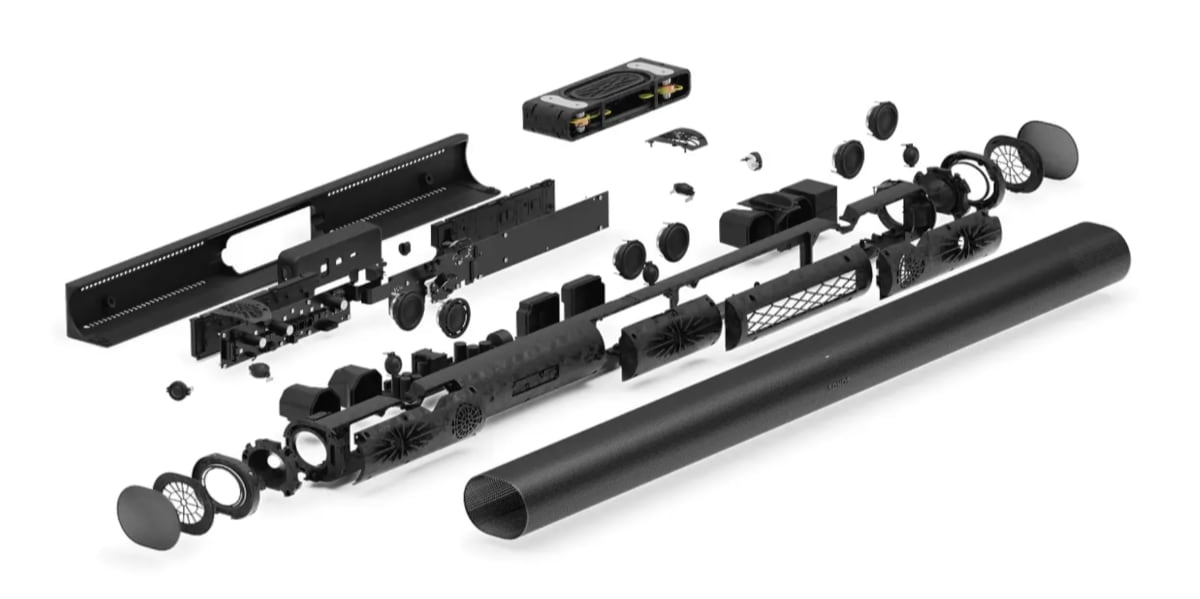
Focusing on Arc Ultra alone, there are certain hardware upgrades compared to Arc. Where Arc is marketed as a 5.0.2 system – 5 channels on the base plane (2x front, 1x center, and 2x rear channels) and 2 height channels delivered by a total of 11 drivers – Arc Ultra is marketed as a 9.1.4 system, featuring 9 channels on the base plane, an added subwoofer, and two additional height channels delivered by a total of 14 drivers. The subwoofer addition is a focal point for Arc Ultra, as it utilizes the Sound Motion technology acquired through Sonos' patent purchase from Mayht. This technology promises significantly enhanced sound without increasing the physical size of the drivers, which is advantageous for this type of speaker where cabinet size is kept minimal. The additional channels aim to enhance the Dolby Atmos experience, making it more immersive. However, Sonos appears pragmatic enough to recognize that even with new patents, a home system may fall short in delivering deep bass. As such, their review sample also includes their newest subwoofer as standard.
In our TV reviews, we often criticize the limited number of two HDMI 2.1 ports on many new TVs, with one of these typically doubling as the HDMI ARC/eARC port. Connecting a soundbar without additional HDMI input consumes one of these precious HDMI 2.1 ports, leaving only one port for game consoles or other HDMI 2.1 players. Sonos Arc Ultra lacks an HDMI input (it only has an HDMI ARC output) and thus cannot compensate for taking an HDMI port on the TV. A single HDMI input would have been a welcome addition to balance this limitation.
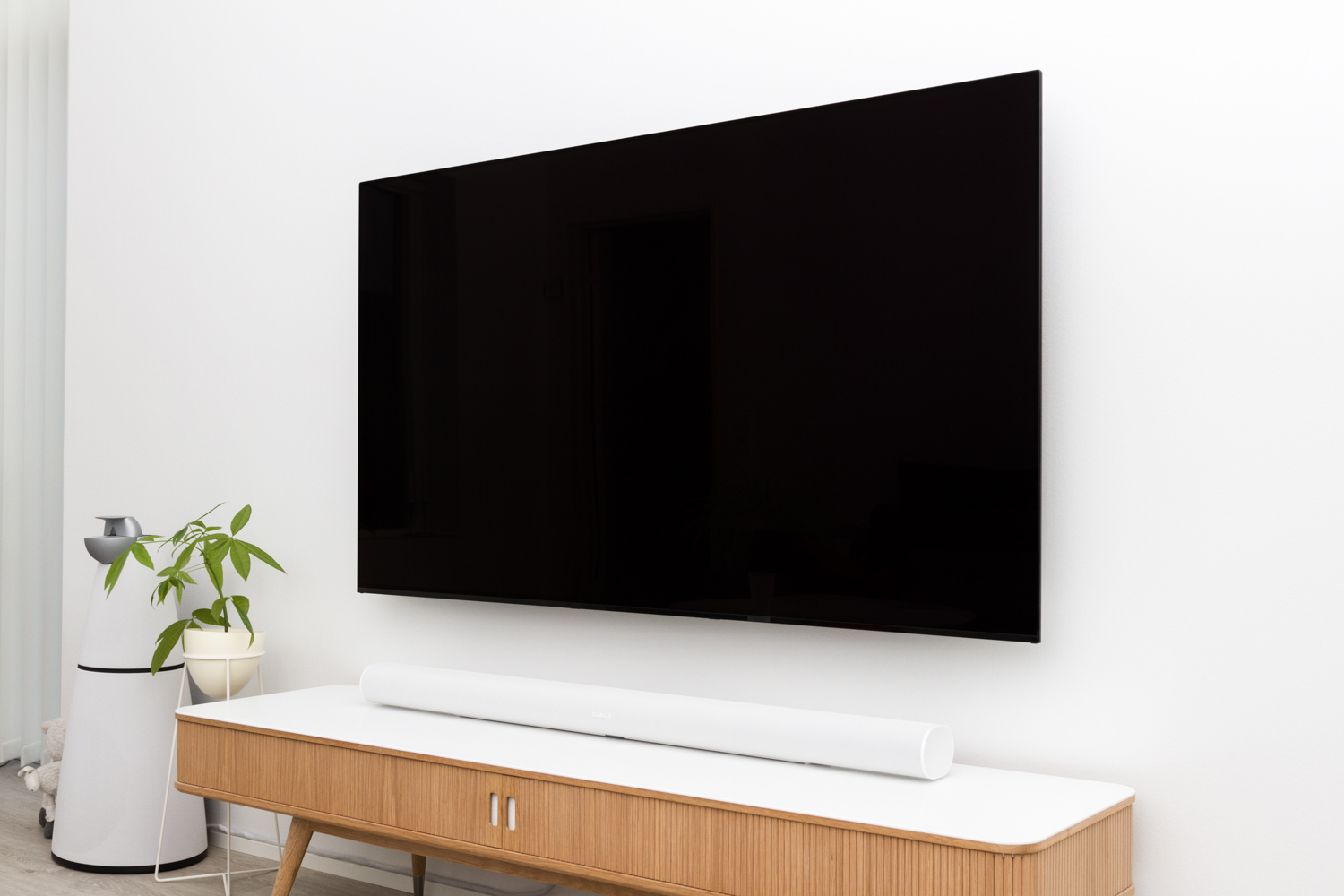
Setup
I have not added new speaker units to my private Sonos setup since the update of the infamous and scandal-ridden Sonos app earlier this summer, so I placed the Arc Ultra on the TV stand in front of my own Sonos Arc with some hesitation.
Adding new equipment to a Sonos setup has previously been a breeze. My system consists of 9 zones, ranging from single speakers, a Sonos Port connected to various Bang & Olufsen speakers, to the living room setup with an Arc, sub, and rear speakers. Everything has worked flawlessly, and I have largely been spared from the issues that you would find thousands of reports about online. However, I have not attempted to add or remove gear since Sonos ran into trouble with the app. Adding Arc Ultra to my system actually went fairly smoothly. The app found the Arc Ultra and started the installation, but after adding it, a pop-up appeared, informing me that new equipment might require a manual restart before it could be used. That was the case here, as Arc Ultra was not showing up in my list of devices. Of course, it is not a scandal that equipment needs to be restarted before it works, but Sonos does not have a power button, so it is a somewhat clumsy solution to have to unplug the device to get it working. After a hard restart, the Arc Ultra was now visible in my system and ready to be tested in various groupings across my own Arc (where I have the sub and Era 300 disconnected) and my B&O Beolab 9s in the same room.
Before I continue, I have to mention that adding the Sonos Sub 4 did not go as smoothly. It first required hardwiring the speaker to my network to get it added – a rather annoying error, which for the average user is made even harder by Sonos no longer including a network cable in the box. After a few software updates to the Sub and the semi-obligatory hard restart via the power socket, it could finally be added to Arc Ultra, but after that, my entire system collapsed. Control over my devices in all rooms stopped, and the app behaved almost as if it were completely disconnected from what was going on. Music could be started and streamed via AirPlay and controlled via some third-party remotes I bought, but the app registered none of this. The system has since returned to normal, but what caused the error, I will leave unsaid – some might yell that it is my Wi-Fi...
After the above incident, I pushed harder by playing music, grouping rooms, and adjusting the Arc Ultra to not let one episode overshadow the review, and I have not experienced any other issues in the weeks the test has been running. In fact, the system has performed better and more smoothly than it has in months, so overall the experience remains positive.
Sonos' latest update to their app, which followed the launch of Sonos Ace that we tested earlier this year, brought significant changes both to the interface and to how the app functions. One of the changes involved a shift from being rooted in the local Sonos system on your home network to being fully controlled by a cloud solution. There can be pros and cons to relying on cloud solutions, but speed is rarely one of the advantages, which can sometimes be noticeable. Navigating the different services that Sonos allows you to add in their app is often accompanied by a delay of a few seconds, and an additional consequence is that without an internet connection in your home, you will not be able to access your Sonos account to add/edit devices. It's worth noting that once the system is set up, Arc Ultra will still play sound from your TV even if the internet connection drops – you just will not be able to use the Sonos app on your phone or tablet to edit your setup.
The Sonos app is intended as a one-stop-shop where you can find and play all your music, whether it is stored locally on a network hard drive or streamed from a music service. Your music services are added like you would install an app on your smart TV, and then you have access to that particular music service through Sonos. Your services will also appear in search results across the system, and you can search freely for artists, albums, tracks, radio stations, and playlists. While other manufacturers might rely more heavily on either AirPlay or Chromecast, Sonos takes much more control to ensure you have access to your music. This is naturally because Sonos' brand has been rooted in multi-room solutions for decades, and handling multiple rooms was previously impossible without using their own solutions. Various multi-room solutions are available on the market, and a common feature is that they must pull content into their app to ensure a good experience across rooms simultaneously.
If you are not a fan of the Sonos app, there is the option to stream music via Apple AirPlay 2 and now Bluetooth, but not Chromecast. That Android users do not have exactly the same options as iPhone users is also seen in the Trueplay feature Sonos uses to calibrate its speakers. Until the latest update, it was only possible to adjust Sonos' speakers to the room using an iPhone – apparently because the microphone's characteristics need to be known, which is impossible with the many Android variants. However, the latest update has opened up the option for the microphones in Sonos speakers to handle the sound calibration themselves. This is a welcome feature, as now everyone can benefit from Sonos' room calibration without needing to invite a friend with an iPhone first.
Unfortunately, I could not get Arc Ultra to work with a set of Sonos Ace (the new headphones). If you have more than one soundbar in your setup, you will be able to select which soundbar Ace should grab the sound from using "Sound Swap", and in the app it seems like the sound should play through Ace, but unfortunately no sound came through. I am sure this will be fixed over time, but it is a bug to be aware of if you have Ace and are considering purchasing Arc Ultra.
Sonos Arc Ultra was tested with a Sony AF9 OLED TV and Apple TV 4K media player, and once Arc Ultra is set up in the app and the HDMI cable is connected, volume can be controlled easily via HDMI CEC and the TV's remote control. I use Apple's remote from Apple TV 4K, which worked seamlessly.
Listening test: Movies
Initially, Arc Ultra was tested alone without the addition of a subwoofer or surround speakers. It was immediately clear that dialogue and sound coming from the center channel are much more direct than on Arc. Speech is clear, and it is a bit easier to pinpoint where the soundbar is placed compared to Arc, with vocals having a more focused emphasis. This also means that you should be cautious when placing Arc Ultra much lower than the TV itself, as the soundstage is less diffuse than on Arc.
The next thing that stands out is that the sound generally feels narrower than on Arc. The shift between the two gives the impression that the sound has been pulled in a bit more toward the listener, reducing the effect from the sides. This i snot necessarily a bad thing, but the result is that you rarely get the sense that the sound is coming from the sides as you do with Arc. It could simply be a consequence of the center channel becoming much clearer.
As soon as action scenes roll across the screen, you get a taste of what Sound Motion has done for a speaker with relatively modest dimensions like Arc Ultra. There is simply much more punch in the lower end of Arc Ultra than Arc was able to deliver on its own. The bass is stronger and better controlled. On Arc, the volume had to be turned up considerably before you could even sense that you were pushing the limits of what the soundbar could handle without help from a subwoofer. I have had to turn down the volume a bit during
Blade Runner 2049 because the music and sound effects pushed my Arc to the edge of what sounded good, but the same scenes are handled much better by Arc Ultra.
For the past few years, I have had a Sonos Sub connected to my living room setup, getting used to a bit more rumble in the low end, and it is clear that Arc Ultra cannot come close to matching that level of sound pressure or depth. However, if you are coming from a TV with no sound beyond the built-in speakers, Arc Ultra will be a significant upgrade. Since Sonos allows you to buy and add extra units over time, it is a good idea to stick with Arc Ultra initially and evaluate the need for a subwoofer over time.
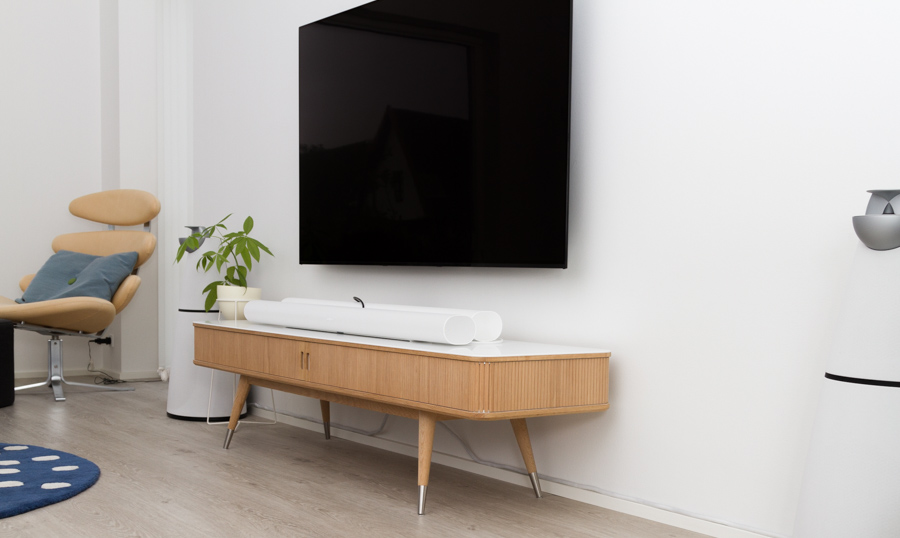
Sonos Arc Ultra (front) and the old Arc (behind). Photo: FlatpanelsHD
The Dolby Atmos effect of the 9.1.4 system is good, although the four height channels do not really feel like true "height". Two of them sound more like high front channels, but overall Arc Ultra fills the room quite well with sound. In discrete listening tests, where I throw the sound around with test tones in each channel, there is a clear difference between most of the channels, so even if they might not all be exactly where they are meant to be in the room each contributes something different to the soundstage. However, it is worth noting that for the price of Arc Ultra, you can get complete soundbar setups with both sub and rear speakers from
for example, Samsung, but in this comparison Arc Ultra simply performs noticeably better if you are only comparing soundbars. As with the subwoofer, the addition of rear speakers is also something you can decide on later, and the selection is a bit broader than with the subwoofer.
Getting sound thrown behind the listener with these soundbars is practically impossible and Sonos Arc Ultra does not quite manage it either. Since there is the option to expand with dedicated rear speakers you should instead appreciate the speaker for what it manages to achieve from such a modest cabinet. With Dolby Atmos soundtracks, Arc Ultra is able to fill especially the area in front of the listener with well-balanced sound that feels like it comes from a much larger speaker than it actually is.
This is a clear upgrade compared to Arc, but whether existing Arc users should upgrade largely depends on how their setup looks today. If you only have an Arc and not a Sub, you will definitely get a larger sound with Arc Ultra. The closer you get to a full Atmos setup with Sub and rear speakers, the less you will get out of the Ultra upgrade. I would not call the more direct center channel "enough" so you should be in the situation I described earlier where Arc loses its breath and the sound overpowers because it cannot keep up at higher volumes. Here, Arc Ultra can keep up a bit longer before the bass distorts.
In its price range, it is hard to point to competitors that can deliver the same complete package that Arc Ultra does, but if you have to look for alternatives, it is probably the Sony Theatre Bar 9 that comes closest, though it requires a subwoofer to be purchased separately.
Listening test: Music
I started the evaluation of the sound in reverse of how it actually took place, as I initially conducted an A/B listening test between Arc and Arc Ultra without using the TV. It is a pleasant task to perform A/B tests on Sonos, as the equipment can be grouped, and individual units in the group can be muted quickly via the app without needing to adjust the volume manually. When starting in regular stereo playback, the first impression you get is how clear the vocals appear on Arc Ultra compared to Arc. In my review of Arc years ago, I criticized it for its muddy and imprecise vocals, which made it unsuitable for listening to music. This has changed significantly on Arc Ultra, which not only provides a much more direct reproduction of sound in front of the speaker but also has a much fuller vocal sound overall. The width of the soundstage feels narrower – similar to when watching movies – but for music it provides an improvement in quality compared to Arc.
With more punch in the bass, the overall dynamics of the speaker are also significantly better than Arc, and although the bass drums in the Eagles' live version of Hotel California from MTV in 1994 cannot blow the foam off your latte, Arc Ultra comes across as a much more harmonious package that could actually be worth sitting down and listening to music with.
In my living room, I have supplemented my own Arc with dedicated stereo speakers, which can be used instead when I listen to music in the living room, which was a result of not finding Arc good enough for music. I would say Arc Ultra can hold its own for music playback, but only if you accept that the soundstage is not the widest on the market. That said, a behemoth like Bang & Olufsen's Beosound Stage does not provide an especially wide soundstage for music either and that is generally a downside of choosing a soundbar.
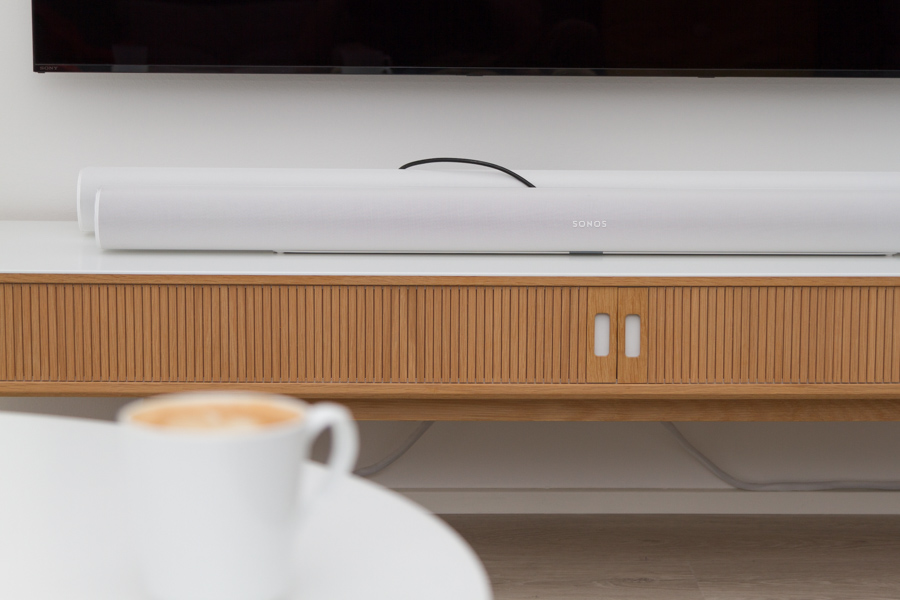
Sonos Arc Ultra (front) and the old Arc (behind). Photo: FlatpanelsHD
Switching to a Dolby Atmos music track (Sonos themselves recommended Bridge over Troubled Water by Jacob Collier), the sound becomes much wider and fills the room more. I prefer to test Atmos music via Apple Music, which offers some music through the Sonos app – streaming via AirPlay does not yet provide Atmos with Sonos. Lukas Graham's I Wish You Were Here, The Weeknd's Blinding Lights, or Billie Eilish's Bad Guy deliver quite good spatial fullness and are regulars in my playlist for listening to Atmos music, but there are many playlists on the service where you can explore different genres. Many newer albums are available in Atmos, so the selection is constantly growing and not limited to special releases. Of the three tracks mentioned, Arc Ultra especially excels with Lukas Graham's vocals, which come across as much less confined than on Arc, while the music fills the room quite well.
The clarity and especially the width on Arc Ultra cannot match the dedicated B&O Beolab 9 speakers I have standing next to it (and the two are not even in the same price range, so that was expected and fair), and even with the subwoofer added, there is still a bit of fullness missing in the midrange where the bass rounds off and the soundbar takes over, which is better suited in my stereo setup. It is worth noting that when I test these two systems against each other, Arc Ultra falls back to the lowest common denominator and since Sonos Port does not support this, the sound is only reproduced in stereo. So this is not a comparison of Beolab 9 in stereo versus Arc Ultra in Atmos. My main issue remains the narrow soundstage, which is very clearly coming from the soundbar, but in many homes you might use a single smart speaker placed centrally and here Arc Ultra is a worthy alternative. Especially if the subwoofer is added.
While listening to music in Dolby Atmos, I did unfortunately experience a few instances where Arc Ultra lost the Atmos effect and reverted to stereo. What caused this is hard to say, but restarting the same track brought Atmos back again. During the test, this happened about 3-4 times.
Conclusion
Sonos has innovated on their already acclaimed Arc soundbar by adding extra Dolby Atmos channels, a much more powerful bass solution, and improved vocal reproduction without significantly changing the physical exterior of the soundbar.
Sonos' app is not quite as reliable as it was 6 months ago, but overall it worked fine and if you primarily use Arc Ultra with your TV, you will not interact with it very often.
Sound-wise, Arc Ultra is a significant upgrade from Arc – perhaps especially if you use the soundbar alone without adding a subwoofer or rear speakers. The performance for music playback is particularly an area where Arc Ultra pulls ahead of Arc. The ability to gradually add a subwoofer and rear speakers is an extra bonus, making it easier to jump into Sonos, as you do not necessarily need to find space or money for a full setup from day one.
Sonos Arc Ultra is not an extra product in Sonos' soundbar lineup as it is set to replace Arc over time, so the question of whether to buy Arc or Arc Ultra is only relevant until Arc is sold out. The real question is whether existing Arc owners should look into Arc Ultra and whether Arc Ultra is worth the money for new buyers. For the first, I believe it depends on what you are missing with Arc. If it is clearer vocals, better bass and usability for music playback, then yes. If it is purely as a soundbar in a setup with Sonos Sub and Era 300, then the answer is probably less clear. For new buyers, Sonos Arc Ultra cannot be ignored. Despite a price increase, Sonos Arc Ultra offers enough value for money to earn our Highly Recommended Award, and if you are in the market for a soundbar costing around $1000, it should definitely be part of your considerations.
Price and retailers:
Significantly improved bass vs. Arc
Clear dialogue
Decent Atmos performence
Wireless ecosystem (rear, subwoofer)
Sonos multi-room
No HDMI input, only eARC
App still broken
Choice of material
Nearest competitors

